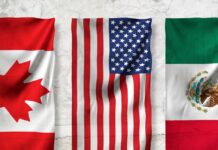“This is a big problem — but it’s been solved,” Mike Leavitt, who served as health and human services secretary under President George W. Bush, told me. “It opens up access for information and the coordination in between the ingoing and outgoing administrations.”
Setting the transition in motion means Team Biden can view the government’s vaccine distribution plans.
Thirty-five volunteers assigned to the Department of Health and Human Services — along with some assigned to other agencies also involved in the vaccine effort — can now participate in the nitty-gritty details of how the Trump administration is planning to manufacture, distribute and administer hundreds of millions of vaccine doses beginning in December and continuing through the bulk of 2021.
The massive effort, central to restoring the United States to more normalcy next year, probably will be in its early stages once Biden is sworn in as president in late January.
Transition experts say it’s critical for his team to evaluate the plans written up so far and make any modifications deemed necessary. These officials will be considering critical questions, such as who should be prioritized for getting the vaccine first and how to overcome logistical challenges around vaccine storage.
“Given the fact that the bulk of the work will happen after the inauguration, there needs to be an alignment on strategy and priorities and logistics,” Leavitt said.
The Biden transition team is already being briefed on the plans.
A transition official told Health 202 there were around 20 meetings between agency teams and staff on Tuesday, with more to come.
“Career staff at federal agencies have been responsive, receptive and helpful within the first few hours of formal engagement,” the official said. “Many have been preparing for this moment for several months and their work is greatly appreciated as we begin making up for some lost time.”
The transition team has also been in touch with Anthony S. Fauci, who Biden has said he would keep as the nation’s top infectious-disease expert, Matt Viser reports.
It all kicked into high gear on Monday night, shortly after Trump allowed the General Services Administration to start the transition process. Rear Adm. Erica Schwartz briefed members of the Biden team on the vaccine plan without hours, according to HHS Secretary Alex Azar. Azar told reporters HHS is “immediately getting them all of the pre-prepared transition briefing materials.”
“We will ensure coordinated briefings with them to ensure they’re getting whatever information that they feel they need,” Azar said, adding that the “transition planning and execution will be professional, cooperative and collaborative.”
Matt Viser, national political reporter for The Post:
Andrew Dunn, pharma and biotech reporter for Business Insider:
For 2½ weeks, Trump refused to acknowledge Biden won the election even as public pressure grew for him to concede. Now that he has finally relented, a peaceful transition of power is underway. Besides gaining access to federal agencies, the president-elect and his administration-in-waiting can tap public funds and receive security briefings.
The transition also means Biden can get his top health appointees teed up in this critical pandemic moment.
Political appointees can’t be confirmed until after the inauguration. But agency ethics officials can begin the long process of vetting candidates, which involves doing background checks and determining any potential conflicts of interest.
Back in 2000, when the contested election resulted in a shorter transition period, President Bush had only half as many top appointees in place after 100 days in office compared with President Barack Obama, according to an analysis by the Center for Presidential Transition.
“Having the right appointees in place quickly is essential for the federal government to protect and advance American interests, particularly at a time of crisis,” analyst Christina Condreay wrote.
Biden hasn’t yet announced his pick for HHS secretary, but former surgeon general Vivek Murthy and New Mexico Gov. Michelle Lujan Grisham (D) are said to be top candidates.
PROGRAMMING NOTE: We won’t be publishing tomorrow and Friday in honor of Thanksgiving. Have a safe and happy holiday and we’ll be back in your inboxes on Monday.
Ahh, oof and ouch
AHH: The CDC is finalizing plans to shorten its recommended coronavirus quarantine time.
Centers for Disease Control and Prevention officials are finalizing plans to change the recommended time for self-quarantine after potential coronavirus exposure in a move aimed at increasing compliance with the public health recommendations. The new quarantine period would likely be between seven and 10 days and would require a negative result from a coronavirus test, the Wall Street Journal’s Betsy McKay reports.
Henry Walke, the CDC’s incident manager for coronavirus response, told the Journal that, while there is a risk some infections will be missed, the agency hopes people will be more likely to comply with shorter quarantines. The current recommendation for a 14-day quarantine is based on the time it can take for someone to manifest symptoms of the virus. But public-health experts estimate only 2 percent of people develop symptoms after two weeks and testing could decrease the risk of missed infections.
“The new recommendation could increase demand for testing at a time when capacity is already strained, potentially making it difficult for some people to quarantine for a shorter period,” McKay writes.
Recommendations for quarantine may also depend on circumstances. A longer quarantine may be advisable for a someone planning to visit vulnerable friends or relatives, for instance. And in countries that have largely suppressed the virus, a longer quarantine could be essential in preventing an infection that could spark a new outbreak.
OOF: Evidence is building that an early mutation made the coronavirus more transmissible.
“For months, scientists have been fiercely debating why. Researchers at Los Alamos National Laboratory argued in May that the variant had probably evolved the ability to infect people more efficiently. Many were skeptical, arguing that the variant may have been simply lucky, appearing more often by chance in large epidemics, like Northern Italy’s, that seeded outbreaks elsewhere,” Glanz, Carey and Beech write.
New research, however, supports the hypothesis that the virus with the 614G mutation is more transmissible than the original variant that first emerged in China.
“One study found that outbreaks in communities in the United Kingdom grew faster when seeded by the 614G variant than when seeded by its Wuhan ancestor. Another reported that hamsters infected each other more quickly when exposed to the variant. And in a third, the variant infected human bronchial and nasal tissue in a cell-culture dish far more efficiently than its ancestor,” Glanz, Carey and Beech report.
Researchers point out that there is no evidence that the mutated virus is more deadly or makes people sicker. And even if it does turn out to be more transmissible, that factor could play only a small role in explaining infection rates between countries compared with aggressive lockdowns, mask wearing and social distancing measures.
OOF: Officials are urging the public to stay home, but not everyone is listening.
“Pandemic fatigue, personal hardships and a lack of financial resources have combined with anti-government sentiment and science denialism to drive a wedge between what public health officials say should be done and what people are actually doing,” Joel Achenbach and Ben Guarino report.
Warnings from public health officials around the coronavirus have become increasingly blunt, perhaps none more so than the messaging campaign coming out of Utah’s Salt Lake County Health Department. “Thanksgiving leftovers won’t taste as good if you’re on a ventilator. In fact, if you’ve got COVID-19, they probably won’t taste like anything at all,” a post from the health department reads.
Meanwhile, mayors and governors have imposed new restrictions in an effort to control surging cases. D.C. Mayor Muriel E. Bowser (D) on Tuesday limited indoor gatherings, including Thanksgiving dinner, to 10 people or fewer and banned live entertainment. In Vermont, Republican Gov. Phil Scott has banned multi-household social gatherings.
“But it is not clear that the measures imposed across the country in the past few weeks are stringent or timely enough to halt the dismaying autumn surge of coronavirus infections that already has pushed some hospitals into crisis and driven up death tolls,” Achenbach and Guarino write. While airline travel is down compared to previous years, at least 3 million passengers went through airline checkpoints between Friday and Sunday.
But as cases continue to rise, some public-health experts warn there will be little choice but to impose shutdowns if hospitals become overwhelmed. The restrictions are especially painful, some experts say, without a relief package from the federal government helping to cushion the blow to businesses and allowing people to isolate away from family members.
Coronavirus latest
Nearly 2,100 Americans died of covid-19 on Tuesday.
The death toll was the highest mark since May 6, when states reported a combined 2,611 virus fatalities, according to data analyzed by The Post. Meanwhile, hospitals continue to report record numbers of coronavirus inpatients, with many in intensive care units or on ventilators.
In California, which seemed to be making progress in controlling the spread of the virus as recently as last month, hospitals are full and the government has issued new rounds of curfews, shutdown orders and mask mandates.
The surging cases across the country have been attributed to cooler weather, more indoor gatherings and a sense of fatigue that may cause people to be less observant of public health precautions. Many cases, however, continue to be fueled by outbreaks in jails, nursing homes and meatpacking plants, as well as restaurants and gyms.
Elsewhere in health care
Purdue Pharma pleaded guilty to criminal charges, acknowledging its role in the opioid epidemic.
The maker of OxyContin admitted paying doctors and an electronic medical records company to encourage physicians to write more prescriptions for opioids. The company also said it misled the Food and Drug Administration when it claimed to have an effective program to prevent diversion of prescription drugs to the black market, the Associated Press’s Geoff Mulvihill reports.
“Purdue’s plea to federal crimes provides only minor comfort for advocates who want to see harsher penalties for the OxyContin maker and its owners,” Mulvihill writes. “The ongoing drug overdose crisis, which appears to be worsening during the coronavirus pandemic, has contributed to the deaths of more than 470,000 Americans over the past two decades, most of those from opioids both legal and illicit.”
The guilty pleas entered in a virtual hearing with a federal judge in Newark were part of a criminal and civil settlement announced last month between Purdue and the Justice Department.
Many activists, as well as attorneys general from states affected by the opioid crisis, are unhappy that the Sackler family managed to avoid criminal charges and remain wealthy. Last week, a group of states opposed to the settlement filed documents that purport to show the Sackler family at the center of Purdue’s push to sell OxyContin.
Advocates are trying to speed psilocybin to terminally ill patients.
Studies have found that psilocybin, the psychoactive ingredient in magic mushrooms, can help patients grappling with depression and the emotional impact of a terminal cancer diagnosis, but the chemical is classified as a Schedule 1 drug under federal law, alongside heroin and LSD.
Now some advocates are trying to get psilocybin into the hands of patients who may not have much time.
“Dr. Sunil Aggarwal, a Seattle palliative care physician, and Kathryn Tucker, a lawyer who advocates on behalf of terminally ill patients and chairs a psychedelic practice group at Emerge Law Group, are championing a novel strategy that would make psilocybin available using state and federal ‘right-to-try’ laws that allow terminally ill patients access to investigational drugs,” Kaiser Health News’s JoNel Aleccia reports.
The move is part of a larger movement to rehabilitate the reputation of psilocybin. Several cities and states have voted to decriminalize possession of the substance, and Oregon this month voted to legalize psilocybin for the treatment of mental health issues.
Obtaining legal psilocybin, however, could be an uphill battle. Companies that manufacture psilocybin for clinical trials have so far been reluctant to supply it for right-to-try uses, wary that anything outside formal clinical trials could make it harder to get FDA approval.








